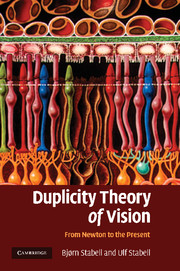Book contents
- Frontmatter
- Contents
- Acknowledgements
- 1 Introduction
- Part I The development of the basic ideas of the duplicity theory from Newton to G. E. Müller
- Part II The development of the duplicity theory from 1930–1966
- Part III Chromatic rod vision: a historical account
- Part IV Theories of sensitivity regulation of the rod and cone systems: a historical account
- Part V Factors that triggered the paradigm shifts in the development of the duplicity theory
- 28 Summary of K.R. Popper's and T.S. Kuhn's models of scientific development
- 29 The development of the duplicity theory as a test of Popper's and Kuhn's models
- References
- Index
29 - The development of the duplicity theory as a test of Popper's and Kuhn's models
Published online by Cambridge University Press: 22 January 2010
- Frontmatter
- Contents
- Acknowledgements
- 1 Introduction
- Part I The development of the basic ideas of the duplicity theory from Newton to G. E. Müller
- Part II The development of the duplicity theory from 1930–1966
- Part III Chromatic rod vision: a historical account
- Part IV Theories of sensitivity regulation of the rod and cone systems: a historical account
- Part V Factors that triggered the paradigm shifts in the development of the duplicity theory
- 28 Summary of K.R. Popper's and T.S. Kuhn's models of scientific development
- 29 The development of the duplicity theory as a test of Popper's and Kuhn's models
- References
- Index
Summary
It is apparent that neither of these models fit well with our description of the development of the duplicity theory. As regards Popper's model, none of the classical theories of Newton, Young, Schultze, Kühne and Hering was triggered by an attempt to falsify or refute current hypotheses or theories. Newton's starting point was the rectangular form of the prismatic solar spectrum he observed when he looked at its beautiful colours; Young based his theory on the old and well-known fact that three pigments were sufficient to produce every object colour; Schultze reflected on the fact that nocturnal and diurnal animals tended to have rod- and cone-dominated retinas, respectively, and that colours were absent in night vision; Kühne's theory was instigated by the great discovery of Boll that rhodopsin bleached in light and regenerated in the dark; and Hering was spurred on by Mach's psychophysical maxim. Thus, there is little evidence of long, fruitful falsification periods ending with falsification of the most successful hypothesis and the development of a new, better one triggered by this last falsification.
It is evident that Maxwell (1855, 1860) provided conclusive evidence in support of Young's trichromatic colour theory by demonstrating that three standard spectral lights were sufficient to produce all spectral colours, but his experiments represented a confirmation of an already existing theory and not a falsification. It should also be noted that Young's theory was immediately accepted by the relevant scientific community without much debate following the discoveries of Maxwell.
Information
- Type
- Chapter
- Information
- Duplicity Theory of VisionFrom Newton to the Present, pp. 203 - 206Publisher: Cambridge University PressPrint publication year: 2009
